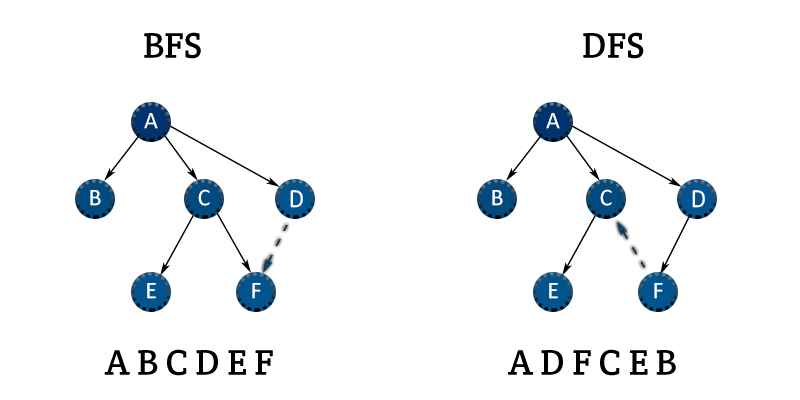Depth-First Search (DFS) and Breadth-First Search (BFS) are two fundamental graph traversal algorithms used to explore and search through graphs. While both algorithms aim to visit all nodes in a graph, they differ in their traversal strategies and the order in which nodes are visited.
Here are the main differences between DFS and BFS:
-
Traversal Strategy:
- DFS: DFS explores a graph by visiting as far as possible along each branch before backtracking. It starts at a specified node (the starting node or root) and explores as deeply as possible along each branch before backtracking to explore other branches.
- BFS: BFS explores a graph by visiting all neighbors of a node before visiting any of their neighbors. It starts at a specified node (the starting node or root) and explores all nodes at the current depth level before moving to the next depth level.
-
Data Structure:
- DFS: DFS is typically implemented using recursion or a stack data structure (either explicit or implicit call stack). When using an explicit stack, nodes are pushed onto the stack as they are visited, and popped off the stack when backtracking.
- BFS: BFS is typically implemented using a queue data structure. Nodes are added to the queue as they are discovered and removed from the queue when they are visited.
-
Order of Node Visits:
- DFS: DFS may visit nodes in any order depending on the specific traversal path chosen. It tends to visit nodes deeply before exploring other parts of the graph.
- BFS: BFS visits nodes in a level-by-level manner, starting from the root and moving outward. Nodes at the same depth level are visited before nodes at deeper levels.
-
Applications:
- DFS: DFS is useful for tasks such as finding paths, cycle detection, topological sorting, and depth-based exploration. It is often used in maze solving, graph traversal, and backtracking algorithms.
- BFS: BFS is useful for tasks such as shortest path finding, connected components, level-order traversal, and breadth-based exploration. It is often used in network routing, social network analysis, and puzzle solving.
-
Space Complexity:
- DFS: The space complexity of DFS depends on the depth of the recursion or the maximum depth of the stack. In the worst case, it may require space proportional to the depth of the deepest branch.
- BFS: The space complexity of BFS depends on the maximum number of nodes at a single depth level. In the worst case, it may require space proportional to the maximum breadth (i.e., the maximum number of nodes at any depth level) of the graph.
In summary, DFS and BFS are both powerful graph traversal algorithms with different strategies and applications. DFS explores deeply before backtracking, while BFS explores broadly before delving deeper. The choice between DFS and BFS depends on the specific requirements of the problem at hand and the characteristics of the graph being traversed.
Thank you,

